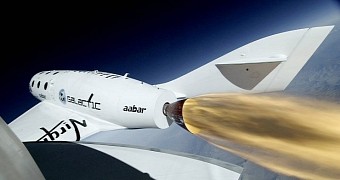Just days ago, on October 31, Virgin Galactic's rocket plane SpaceShipTwo crashed in the Mojave Desert in southeastern California, US. The incident is now under investigation, and Virgin Galactic expects that it will soon be revealed how and why its aircraft fell to the ground.
In a statement issued yesterday, November 2, commercial spaceflight company Virgin Galactic explains that, although SpaceShipTwo was its rocket plane, the investigation into its crash is carried out by experts with the National Transportation Safety Board.
The company goes on to detail that it is cooperating fully with the Board, and that it is only a matter of time until the cause of the crash becomes clear. Meanwhile, it asks that people refrain from making any speculations concerning this tragic incident.
The details of SpaceShipTwo's crash
As mentioned, Virgin Galactic's rocket plane SpaceShipTwo fell to the ground and crashed in California's Mojave Desert this past October 31. At that time, the aircraft was performing a test flight and was carrying pilot Peter Siebold and co-pilot Michael Alsbury.
Shortly after the news of this accident hit the public, it was announced that 39-year-old Michael Alsbury lost his life in the crash. Pilot Peter Siebold survived but suffered serious injuries. He now finds himself in the hospital, and doctors are treating his wounds.
It is understood that the pilot survived because he somehow managed to parachute himself out of the aircraft before it hit the ground. Thus, he was found at a considerable distance from the plane's remains. The body of co-pilot Michael Alsbury, on the other hand, was found tangled in the wreckage.
According to Nature, remains of the rocket plane are scattered over an area of about 8 square kilometers (roughly 3 square miles) in the Mojave Desert. This indicates that, rather than simply crashing, the rocket plane broke apart mid-flight.
The October 31 test flight was carried out in order to experiment with a new rocket motor and fuel. “We were flying a rocket motor today that had been thoroughly tested on the ground,” Kevin Mickey, president of Scaled Composites, the Mojave-based company that built SpaceShipTwo, said in a statement.
The future of commercial space travel
Despite this tragic incident involving its rocket plane SpaceShipTwo, it appears that Virgin Galactic has no intention to drop its plans to carry regular folks into space sooner rather than later. More so given the fact that over 700 people have already made reservations for one such journey to the edge of the world and back.
Then again, seeing how the rocket plane that crashed this past October 31 was the very same one that the company expected would carry passengers into space, chances are that Virgin Galactic will at have to settle for later.
Commenting on this tragic accident, the company wished to stress that “All of us at Virgin Galactic understand the importance of our mission and the significance of creating the first ever commercial space line. This is not a mission that anyone takes lightly.”
“Everything we do is to pursue the vision of accessible and democratized space – and to do it safely. Just like early air or sea travel, it is hard and complicated, but we believe that a thriving commercial space industry will have far reaching benefits for humanity, technology and research for generations to come,” it added.

 14 DAY TRIAL //
14 DAY TRIAL //